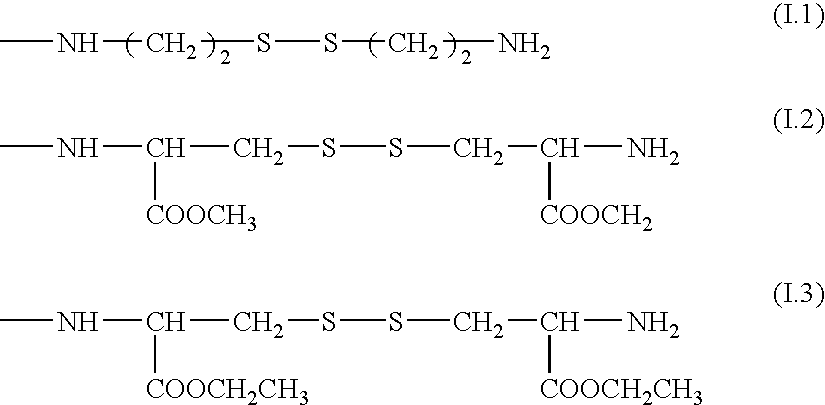Collagen peptides modified by grafting mercapto functions, method for the production thereof and uses thereof as biomaterials
a technology of collagen peptides and mercapto, which is applied in the field of collagen peptides, can solve the problems of poor mechanical characteristics, difficult handling, and inability to use certain applications, and achieve the effects of mechanical and biodegradation properties to be modified and good solubility
- Summary
- Abstract
- Description
- Claims
- Application Information
AI Technical Summary
Benefits of technology
Problems solved by technology
Method used
Image
Examples
example 1
Synthesis of a Collagenic Peptide (2nd Subfamily) in which the Carboxylic Acids are Substituted with Cysteine Ethyl Ester (Degree of Substitution Representing 0.8% of the Amino Acids)
1) Step I: Coupling (Production of 1st Subfamily):
[0121]25 g of atelocollagen (types I+III, extracted from calf skins, 1.3 mmol of COOH / g) are placed in 2.5 l of water and the temperature of the medium is raised to 50° C. with stirring. The 1% w / v solution thus obtained is filtered through a 0.22 μm filter.
[0122]Once the temperature has fallen to 30° C., 46.5 g of cystine diethyl ester are added and the pH is adjusted to 4.2. 0.6 g of 1-(3-dimethylaminopropyl)-3-ethylcarbodiimide HCl is then added and the reaction is left to proceed for 2 h at 30° C. with stirring. The reaction medium is concentrated to 5% w / v and dialyzed against water to remove the excess reagents and the reaction byproducts.
[0123]The product obtained is a stable synthetic intermediate. It is a collagenic peptide (1st subfamily) a fra...
example 2
Synthesis of a Collagenic Peptide (2nd Subfamily) in which the Carboxylic Acids are Substituted with Cysteine Ethyl Ester (Degree of Substitution Representing 3 Mol % of the amino Acids)
[0131]Example 1 is repeated, the only difference being that the amount of coupling agent is 2.9 g.
[0132][SH]: 0.347 mmol / g of dry product, i.e. 3.3 mol % of substituted amino acids.
example 3
Synthesis of a Collagenic Peptide (2nd Subfamily) in which the Carboxylic Acids are Substituted with Cysteine Ethyl Ester (Degree of Substitution Representing 7 Mol % of the Amino Acids)
[0133]Example 1 is repeated, the only difference being that the amount of coupling agent is 12 g.
[0134][SH]: 0.706 mmol / g of dry product, i.e. 7 mol % of substituted amino acids.
PUM
| Property | Measurement | Unit |
|---|---|---|
| temperature | aaaaa | aaaaa |
| temperature | aaaaa | aaaaa |
| pH | aaaaa | aaaaa |
Abstract
Description
Claims
Application Information
 Login to View More
Login to View More - R&D
- Intellectual Property
- Life Sciences
- Materials
- Tech Scout
- Unparalleled Data Quality
- Higher Quality Content
- 60% Fewer Hallucinations
Browse by: Latest US Patents, China's latest patents, Technical Efficacy Thesaurus, Application Domain, Technology Topic, Popular Technical Reports.
© 2025 PatSnap. All rights reserved.Legal|Privacy policy|Modern Slavery Act Transparency Statement|Sitemap|About US| Contact US: help@patsnap.com



